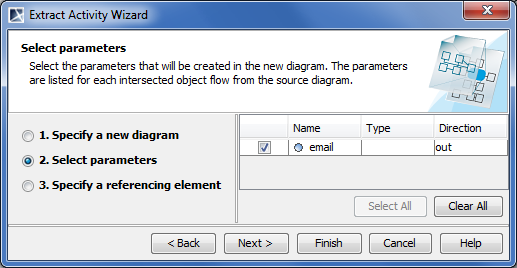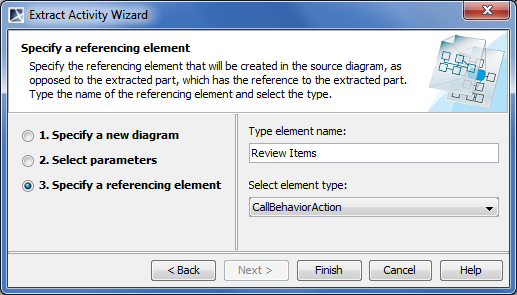The Extract Activity Wizard is used for extracting a selected part of an activity diagram to a separate diagram.
Using this wizard, you can:
- Create and specify the target diagram that will be created as the result of the extraction. The selected part will be extracted to the newly created diagram.
- Select the parameters that will be created in a new diagram. The parameters are listed for each intersected object flow from the source diagram.
- Specify a referencing element that is created in the source activity diagram and represents the elements moved to the target diagram during the extraction.
To start the Extract Activity Wizard
- In the activity diagram, select a part that you want to extract.
- From the selected part’s shortcut menu, choose Refactor > Extract. The Extract Activity Wizard opens.
This section describes components of the Extract Activity Wizard, such as text boxes and buttons.
The Extract Activity Wizard consists of three steps:
- Specification of a new element
- Creation of parameters
- Creation of a reference element
Step #1. Specification of a new diagram
In this step, you can specify a diagram into which the extracted part will be moved and a package wherein this new diagram will be created. You can also define the type of a newly created diagram here. The activity diagram type is selected by default.
The new diagram will be created along with a new activity - the diagram will be created as an inner activity element.

| Element name | Description |
|---|---|
| Type diagram name | Type the name of the new diagram wherein the extracted part will be stored. |
| Select owner | In the model tree, select a package, profile, or model as the owner for the newly created activity. You can also:
|
| Select diagram type | Open the list and select the diagram type for the extracted part. The default diagram type is activity diagram. You can also select to create an interaction overview diagram. By using the customized plugins, you can add custom diagrams to the diagram type list. |
After you have specified the new diagram name, owner of the diagram, and the type of the new diagram, do one of the following:
- Click Next, if you want to specify parameters and to define a referencing element. The next wizard step opens.
- Click Finish. The selected part of an activity diagram is extracted to a new diagram that is specified in this step. Instead of the extracted part, the Call Behavior Action is created in the activity diagram referencing to the newly created diagram. The second and the third wizard steps are skipped - that is the default options are taken.
Step #2. Selection of parameters
The parameter(s) that will be created for the intersected object flow is listed in this step. Along with the parameter(s) in the newly created target diagram, the activity parameter node will be created. The activity parameter node has the pin created as an inner element, as well as the assigned parameter.

- The Select parameters list is empty unless there are intersected object flows selected in the source activity diagram.
- For more information about intersected object flows, see concepts in Extracting.

Step #3. Specification of a referencing element
A referencing element is created in the source diagram instead of the extracted part. Double-click the referencing element to navigate to the extracted part.

| Element name | Description |
|---|---|
| Type element name | Type the name of the referencing element that will be created in the source activity diagram in place of the selected elements. |
| Select element type | Open the list and select the referencing element type. The default referencing element type is a call behavior action. Custom elements can be added to the referencing element type list using customized plugins. |
After you have selected the parameters, do one of the following:
- Click Back to return to the first step.
- Click Finish. The selected part of an activity diagram is extracted to a new diagram.